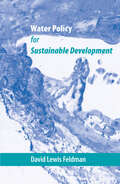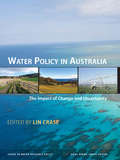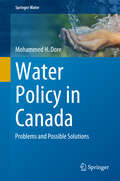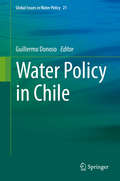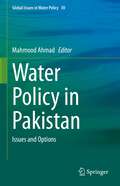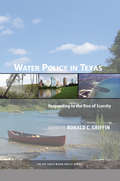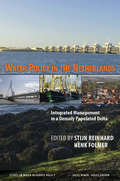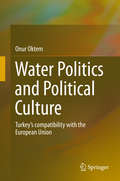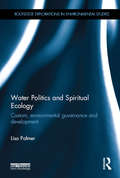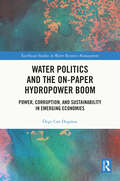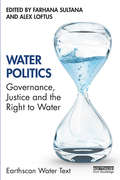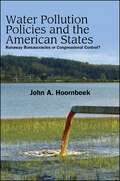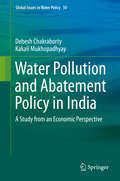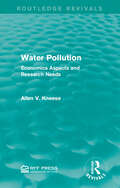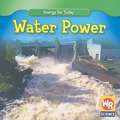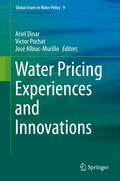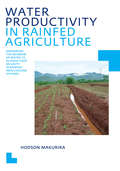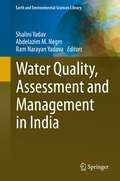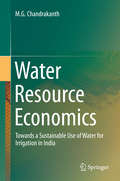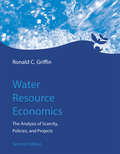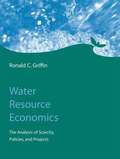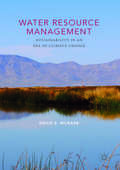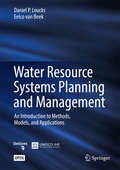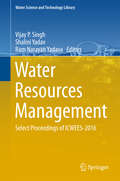- Table View
- List View
Water Policy for Sustainable Development
by Dave FeldmanThe shortage of fresh water is likely to be one of the most pressing issues of the twenty-first century. A UNESCO report predicts that as many as 7 billion people will face shortages of drinking water by 2050. Here, David Lewis Feldman examines river-basin management cases around the world to show how fresh water can be managed to sustain economic development while protecting the environment. He argues that policy makers can employ adaptive management to avoid making decisions that could harm the environment, to recognize and correct mistakes, and to monitor environmental and socioeconomic changes caused by previous policies. To demonstrate how adaptive management can work, Feldman applies it to the Delaware, Susquehanna, Apalachicola-Chattahoochee-Flint, Sacramento–San Joaquin, and Columbia river basins. He assesses the impacts of runoff pollution and climate change, the environmental-justice aspects of water management, and the prospects for sustainable fresh water management. Case studies of the Murray-Darling basin in Australia, the Rhine and Danube in Europe, the Zambezi in Africa, and the Rio de la Plata in South America reveal the impediments to, and opportunities for, adaptive management on a global scale.Feldman's comprehensive investigation and practical analysis bring new insight into the global and political challenges of preserving and managing one of the planet's most important resources.
Water Policy in Australia: The Impact of Change and Uncertainty (Issues in Water Resource Policy)
by Lin CraseIn the last twenty years, policy makers in Australia have been forced to acknowledge that it is not possible to perpetually supply more water at a low cost. Consequently, the country has begun to focus on water resource management through legislative and institutional change attempting to allocate water in a more economically efficient and socially and environmentally acceptable manner. This book provides insight into the challenges of institutional change, as well as valuable lessons on the design of property rights for complex resources. Contributors from across disciplines address pertinent issues, such as irrigation in the Murray-Darling basin, one of Australia's largest drainage divisions; the progression from common law riparian rights to share-based entitlements that encourage sustainable water use; and the potential outcomes of the recent National Water Initiative, a wide-ranging strategy to improve water management and simultaneously maintain healthy groundwater and river systems.
Water Policy in Canada
by Mohammed H. DoreThis book deals with the water policy and management in Canada. It discusses various problems and risks in the fresh and drinking water supply in the second largest country in the world. Mohammed Dore argues that water is underpriced and used wastefully in Canada. In selected case studies, he illustrates the major threats from human activity to Canadian freshwaters and drinking water resources, including manufacturing, mining, oil sands production, animal farming and agricultural use. Selected case studies include reviews of even dramatic incidences, e. g. the Walkerton tragedy of 2000, when 7 people were killed and 200 went onto permanent dialysis treatment because of water contamination with harmful pathogens. The book warns that wastewater treatment standards are often not sufficient, so that many drinking water resources are in peril of wastewater contamination. As most of the water resources are provincial responsibility, the book discusses the water management policies in the different provinces separately. Through a detailed discussion and statistical analyses, it can define water policy and management lessons that emerge from the investigated case studies. It ends by contrasting water policy and practice in Canada with the practice in some European countries.
Water Policy in Chile (Global Issues in Water Policy #21)
by Guillermo DonosoThis book offers a detailed examination of the main sources of Chile’s water, its principle consumers, the gap between supply and demand, hydrological droughts, and future projected impacts of climate change. It describes, analyzes and evaluates the performance of water policies, laws and institutions, identifies the main challenges that Chile needs to face and derives lessons learnt from Chile’s reform experience.Expert contributors discuss such topics as Chile’s water policy, and the reasoning which explains its policy reform. The book presents and evaluates the performance of the legal and institutional framework of water resources. It also describes efforts to meet actual demands for water by augmenting supplies with groundwater management, waste water re-use and desalination and improve the state of water ecosystems. The last chapter presents the editor’s assessment and conclusions. The case of Chile is illustrative of a transition from command and control to market based management policies, where economic incentives play a significant role in water management.
Water Policy in Pakistan: Issues and Options (Global Issues in Water Policy #30)
by Mahmood AhmadThe water policy issues are well- documented in a large set of reports and studies, completed over time showing that the policy prescription and its implementation has been weak in the past as this book reveals. The key reforms initiated were lost due to a lack of government’s will and commitment and more so by pervasive political economy of water. Given this background, each chapter in the book follows a balanced approach in seeking and evaluating alternate solutions to water management issues, especially improvements in water governance and tackling new challenges emerging from the climate change in the short and long term. This approach underpins the importance of moving from the culture of piloting projects to actual implementation on an impact-oriented scale. The book would also highlight that most of the water solutions lie outside the water sector such as agriculture, population, economy, etc. Post COVID-19 policies are exploring new food-health nexus that calls for nature based solutions for our future agriculture growth. The book would show case pioneer work underway in Pakistan on how new policy discourse can reduce water use in agriculture without investing in expensive water technology and infrastructure, thus saving enough water for other competing purposes.
Water Policy in Texas: Responding to the Rise of Scarcity (Rff Press Water Policy Ser.)
by Ronald C. GriffinAs a water-scarce state with deep cultural attachments to private property rights, Texas has taken a unique evolutionary path with regard to water management. This new resource surveys past and current challenges for managing both groundwater and surface water, telling a comprehensive story about water policy in Texas, and identifying opportunities for improving future governance. Texas is the U.S. state that has experimented most thoroughly with water markets. In Water Policy in Texas, experts from broad disciplinary perspectives describe and analyze Texas water laws and management agencies, and the practices of water marketing and rate making in Texas. They explore the unique cases of the Edwards and Ogallala aquifers, the science and policy of environmental water stewardship, the extensive history of formalized water sharing with neighboring states and Mexico, and the opportunities for harnessing new technologies that might aid in addressing scarcity. This multidimensional, interdisciplinary book will be a valuable resource for students and researchers of Texas water policy, as well as for water managers worldwide, particularly those working within contexts of water scarcity.
Water Policy in the Netherlands: Integrated Management in a Densely Populated Delta
by Stijn Reinhard Henk FolmerAs a low-lying delta region with a high population density, the Netherlands has long focused on the prevention of flooding catastrophes and the reclamation of valuable land. The evolution of Dutch water governance, beginning with the creation of local 'water boards' in the Middle Ages and growing into a complex infrastructure of polders, dams, and controlled waterways offers a compelling study of pitfalls and successes within one of the worlds most challenging regions for water management. Water Policy in the Netherlands traces the arc of water governance in the country, from technological innovations to prevent wide-scale flooding, to strategies focused primarily on improving water quality, to an integral water management approach which brings together perspectives from economics, hydrology, ecology, water law, and water technology. The contributions in this book demonstrate how both the technical and social sciences must play key roles in crafting policy in the face of serious environmental challenges including climate change, sea level rise, and increasing soil subsidence. Innovative themes explored in the work include: how economic models and pricing structures might improve efficiency in the distribution of water resources, how the competing uses for water-including for recreation, arable agriculture, fisheries, and natural preservation-create demands on both the quantity and quality of water resources, and how public participation, cogovernance, and the balance of public and private interests will be necessary to meet the goals of the EU‘s Water Framework Directive. This resource serves as both an invaluable case study and as a text to develop the analytical tool of integral water management for students, policy-makers, and NGO professionals in developed and developing regions.
Water Politics and Political Culture
by Onur OktemThis book presents an analysis of the main traits of the Turkish political culture and articulates some of the most important deeply embedded social qualifications of political life in Turkey. It reveals that when water management is historically and socially shaped by heavily technical knowledge systems of engineering it becomes a particularly useful tool for various political interests. The book analyses how Turkish freshwater management is socially constructed as both an engineering discourse and a paternalistic bureaucratic transaction. Such a construction stands in stark contrast to the water management discourse of the European Water Framework Directive (WFD), the European Union's common water policy. Of all the issues faced in Turkish water management, none are as important and problematic as the issue of complying with European Union (EU) accession criteria. Not only is water socially, economically and environmentally important; its water management is a useful prism through which the EU accession process can be viewed as a whole. It showcases the complementarities and divergences between Turkish and EU bureaucratic constructs and value systems.
Water Politics and Spiritual Ecology: Custom, environmental governance and development (Routledge Explorations in Environmental Studies)
by Lisa PalmerAs water resources diminish with increasing population and economic pressures as well as global climate change, this book addresses a subject of ever increasing local and global importance. In many areas water is not only a vital resource but is also endowed with an agency and power that connects people, spirit beings, place and space. The culmination of a decade of ethnographic research in Timor Leste, this book gives a critical account of the complex social and ecological specificities of a water-focused society in one of the world’s newest nations. Comparatively framed by international examples from Asia, South America and Africa that reveal the need to incorporate and foreground cultural diversity in water governance, it provides deep insight into the global challenge of combining customary and modern water governance regimes. In doing so it addresses a need for sustained critical ecological inquiry into the social issues of water governance. Focusing on the eastern region of Timor Leste, the book explores local uses, beliefs and rituals associated with water. It identifies the ritual ecological practices, contexts and scales through which the use, negotiation over and sharing of water occurs and its influence on the entire sociocultural system. Building on these findings, the book proposes effective conceptual and methodological tools for advancing community engagement and draws out lessons for more integrated and sustainable water governance approaches that can be applied elsewhere. This book will be of great interest to students and researchers in environmental studies, environmental policy and governance.
Water Politics and the On-Paper Hydropower Boom: Power, Corruption, and Sustainability in Emerging Economies (Earthscan Studies in Water Resource Management)
by Özge Can DogmusThis book examines how the on-paper hydropower boom impacts the safe and fair access to water and energy in emerging economies.The global hydropower boom is largely made up of small hydropower plants located in emerging economies, but a lack of funding, over-ambitious planning, and corruption have halted the production of these projects. Describing this state as the ‘on-paper’ hydropower boom, this book shifts attention to the hydrosocial problems arising from hydropower projects that remain on paper. It examines how these proposed but unbuilt projects can lead to disruptions in the control and governance of water resources and increase the international dependence of emerging countries due to deep problems in their sustainable development planning and how all this can affect both ecosystems and the communities that depend on them. In doing so, it critically examines the dominant discourses on energy security and sustainable development, emphasises the extent to which the effects of global imperialism are at play, and examines the effects of international power relations in the hydrosocial context and their implications for perpetuating international relations of dependency. Further, this book provides a unique perspective on the global hydropower boom by highlighting that although the global hydropower boom largely remains on paper, it can still have a significant impact on human–water systems. Contributing to the debate on hydrosocial relationships, each chapter offers an insightful examination of the social, cultural, and political interactions that humans have with water and uses these insights to provide a nuanced understanding of the challenges and issues associated with on-paper plans.This book will be of great interest to students and scholars of water politics, water governance, political ecology, corruption and environmental economics, as well as sustainable development policymakers.
Water Politics: Governance, Justice and the Right to Water (Earthscan Water Text)
by Alex Loftus Farhana SultanaScholarship on the right to water has proliferated in interesting and unexpected ways in recent years. This book broadens existing discussions on the right to water in order to shed critical light on the pathways, pitfalls, prospects, and constraints that exist in achieving global goals, as well as advancing debates around water governance and water justice. The book shows how both discourses and struggles around the right to water have opened new perspectives, and possibilities in water governance, fostering new collective and moral claims for water justice, while effecting changes in laws and policies around the world. In light of the 2010 UN ratification on the human right to water and sanitation, shifts have taken place in policy, legal frameworks, local implementation, as well as in national dialogues. Chapters in the book illustrate the novel ways in which the right to water has been taken up in locations drawn globally, highlighting the material politics that are enabled and negotiated through this framework in order to address ongoing water insecurities. This book reflects the urgent need to take stock of debates in light of new concerns around post-neoliberal political developments, the challenges of the Anthropocene and climate change, the transition from the Millennium Development Goals (MDGs) to the Sustainable Development Goals (SDGs), as well as the mobilizations around the right to water in the global North. This book is essential reading for scholars and students of water governance, environmental policy, politics, geography, and law. It will be of great interest to policymakers and practitioners working in water governance, as well as the human right to water and sanitation.
Water Pollution Policies and the American States: Runaway Bureaucracies or Congressional Control?
by John A. HoornbeekThe relationship between federal and state water pollution policies is revealed and assessed in this incisive volume. Focusing on Congress's statutory directions in the Federal Water Pollution Control Act of 1972 and state compliance, this study throws into relief the complex and often troubled relationship between the laws enacted by Congress and the public policies produced by state governments that implement them. Compliance at the state level can be affected and sometimes disturbed by state politics, particular policymaking processes, and the effects of federal oversight practices. As convincingly demonstrated in these pages, American water pollution policy reflects neither runaway bureaucracies nor Congressional control, but rather a complex intergovernmental process that is structured around Congress's statutory directions.
Water Pollution and Abatement Policy in India
by Kakali Mukhopadhyay Debesh ChakrabortyIndia has been traditionally well-endowed with large freshwater reserves, but increasing population, urbanization and agricultural growth in recent decades are causing overexploitation of surface and groundwater. As consumption of water grows, wastewater increases significantly and in the absence of proper measures for treatment and management, is polluting existing freshwater reserves. As a result, water pollution has emerged as one of the nation's gravest environmental threats. This book draws a link between water pollution generated by different industries and the various economic activities of the Indian economy using the Input-output framework. It constructs a detailed water pollution coefficient matrix involving different types of water pollutants. The book estimates the total amount of water pollution generated directly and indirectly in different sectors and activities, and also calculates the water pollution content in India's foreign trade sector. It also accounts for defensive expenditure from water pollution and estimates Green GDP for the extent and scope of environmental challenges. Analysis of the result indicates the variation in the pollution content of different economic activities. Finally, the book offers a portfolio of policies and assesses the implications of such policies on pollution generation in India.
Water Pollution: Economics Aspects and Research Needs (Routledge Revivals)
by Allen V. KneesePublic agencies and industry will probably spend tens of billions of dollars on new water pollution abatement facilities in the next few decades. Added billions will be spent for the operation of new and existing facilities. How can physical science research reduce the cost of achieving objectives? And how can social science research make sure that the right objectives are being efficiently pursued? This title, first published in 1962, is directed to the orientation of the research effort, and the tool used for this purpose is an economic framework. This book will be of interest to students of economics and environmental studies.
Water Power
by Tea BenduhnIf you've ever seen a crashing ocean wave or a rushing waterfall, you've seen water power in action. People have used flowing water to do work for centuries. Today, water power is a dependable resource for making electricity. Learn why water is such a great source of energy and the different ways we might use it in the future.
Water Pricing Experiences and Innovations
by Ariel Dinar Víctor Pochat José Albiac-MurilloWater pricing to achieve conservation in scarce water resources is a major policy challenge. This book provides credible evidence from water pricing experiences in various countries around the world. The book chapters, written by experts in water pricing from various countries, documents the past 10 to 15 years of water pricing experiences in Australia, Brazil, Canada, China, Colombia, France, India, Israel, Italy, Mexico, The Netherlands, New Zealand, South Africa and Spain. The book includes also several chapters that review innovations in water pricing in various countries, such as new reform mechanisms, achieving social objectives via water pricing, achieving revenue recovery, water use efficiency and customer equity, and charging the poor.
Water Productivity in Rainfed Agriculture: Redrawing the Rainbow of Water to Achieve Food Security in Rainfed Smallholder Systems (IHE Delft PhD Thesis Series)
by Hodson MakuriraThe challenge of water scarcity as a result of insufficient seasonal rainfall and dry spell occurrences during cropping seasons is compounded by inefficient agricultural practices by smallholder farmers where insignificant soil and water conservation efforts are applied. The hypothesis of this research is that many of the past research efforts have
Water Quality, Assessment and Management in India (Earth and Environmental Sciences Library)
by Abdelazim M. Negm Shalini Yadav Ram Narayan YadavaThis book presents up-to-date information on the status of water resources in India. It presents an assessment of the surface water and groundwater condition to help stakeholders take the necessary actions to control pollution and make the country’s water resources sustainable. The book addresses various topics, including forest-water interactions for governing water quality at catchment scales, water quality status, rainwater harvesting methods, acid-mine drainage, water pollution, management strategies, drinking water quality, and treatment of industrial wastewater. Given its scope, the book offers a valuable tool for policy planners who wish to improve the current situation and move toward sustainable water resources in India.
Water Resilience for Human Prosperity
by Carl Folke Johan Rockström Malin Falkenmark Carl Folke Mats Lannerstad Jennie Barron Elin Enfors Line Gordon Jens Heinke Holger Hoff Claudia Pahl-Wostl Johan Rockström Malin Falkenmark Mats Lannerstad Jennie Barron Elin Enfors Line Gordon Jens Heinke Holger HoffThe world's human population now constitutes the largest driving force of changes to the biosphere. Emerging water challenges require new ideas for governance and management of water resources in the context of rapid global change. This book presents a new approach to water resources, addressing global sustainability and focusing on socio-ecological resilience to changes. Topics covered include the risks of unexpected change, human impacts and dependence on global water, the prospects for feeding the world's population by 2050, and a pathway for the future. The book's innovative and integrated approach links green and blue freshwater with terrestrial and aquatic ecosystem functions and use. It also links changes arising from land-use alteration with the impacts of those changes on social-ecological systems and ecosystem services. This is an important, state-of-the-art resource for academic researchers and water resource professionals, and a key reference for graduate students studying water resource governance and management.
Water Resource Economics
by M. G. ChandrakanthThis book uses resource economics costing approaches incorporating externalities to estimate the returns for the country's irrigation and demonstrates how underestimating the cost of water leads farmers to overestimate profits. The importance of the subject can be judged in light of the fact that India is the largest user of groundwater both for irrigation and for drinking purposes, pumping twice as much as the United States and six times as much as Europe. Despite water's vital role in ensuring economic security for the nation and farmers alike by supporting more than 70% of food production, water resource economists are yet to impress upon farmers and policymakers the true value of water and the urgent need for its sustainable extraction, recharge and use. In an endeavor to promote more awareness, the book further delineates the roles of the demand side and supply side in the economics of irrigation, and explains how the cost of water varies with the efforts to recharge it, crop patterns, degrees of initial and premature well failure and degrees of externalities. It also discusses the importance of micro-irrigation in the economics of saving water for irrigation, estimating the marginal productivity of water and how it improves with drip irrigation, the economics of water sharing and water markets, optimal control theory in sustainable extraction of water, payment of ecosystem services for water and how India can effectively recover. In closing, the book highlights the role of socioeconomic and hydrogeological factors in the economics of irrigation, which vary considerably across hard rock areas and the resulting limitations on generalizing.
Water Resource Economics, second edition: The Analysis of Scarcity, Policies, and Projects
by Ronald C. GriffinUpdated edition of a comprehensive introduction to the economics of water management, with self-contained treatment of all necessary economic concepts.Economics brings powerful insights to water management, but most water professionals receive limited training in it. The second edition of this text offers a comprehensive development of water resource economics that is accessible to engineers and natural scientists as well as to economists. The goal is to build a practical platform for understanding and performing economic analysis using both theoretical and empirical tools. Familiarity with microeconomics or natural resource economics is helpful, but all the economics needed is presented and developed progressively in the text.The book focuses on the scarcity of water quantity (rather than on water quality). The author presents the economic theory of resource allocation, recognizing the peculiarities imposed by water, and then goes on to treat a range of subjects including conservation, groundwater depletion, water law, policy analysis, cost–benefit analysis, water marketing, privatization, and demand and supply estimation. Added features of this updated edition include a new chapter on water scarcity risk (with climate change and necessary risk tools introduced progressively) and new risk-attentive material elsewhere in the text; sharper treatment of block rates and pricing doctrine; expanded attention to contemporary literature and issues; and new appendixes on input–output analysis, water footprinting and virtual water, and cost allocation. Each chapter ends with a summary and exercises.
Water Resource Economics: The Analysis of Scarcity, Policies, and Projects
by Ronald C. GriffinEconomics brings powerful insights to water management, but most water professionals receive limited training in it. This text offers a comprehensive development of water resource economics that is accessible to engineers and natural scientists as well as economists. The goal is to build a practical platform for understanding and performing economic analysis using both theoretical and empirical tools. The mathematics needed to understand the subjects covered in this text include basic optimization methods and integral calculus. Familiarity with microeconomics or natural resource economics is helpful, but all the economics needed is presented and developed progressively in the text. Many water-based example calculations are included. Thus the book can be used for independent study as well as course work. The book focuses on the scarcity of water quantity (rather than water quality). The author presents the economic theory of resource allocation, recognizing the peculiarities imposed by water, and expands the theory to encompass time-defined matters such as ground water depletion. He then discusses such subjects as institutional economics, water law, how economics is used in policy and cost-benefit analysis, the roles of water marketing and water pricing, demand and supply estimation, privatization, and modeling with demand and supply functions. As an aid to readers with specific interests, references to recent literature are given for all of these topics. Each chapter ends with a summary and exercises. All graphic portrayals of economic theory and most calculations are performed using Mathematica software. These programs are downloadable, but their use is entirely optional.
Water Resource Management
by David E. McnabbThis book is about how water managers in the United States are responding to the call for increased effort to achieve sustainable supplies of clean fresh water for present and future generations. The author, himself a participant in the water supply chain, demonstrates that while water is indeed one of life's most essential commodities, in many parts of the United States it is one of the most stressed resources. Throughout the book the author illustrates both the good and the bad efforts taken or not taken by water and wastewater management with real life examples. This book will appeal to the educators, students, volunteers, elected officials, regulators, and other participants with a role in helping the suppliers of water and wastewater services to achieve their goals providing clean, safe water on a sustainable basis.
Water Resource Systems Planning and Management
by Daniel P. Loucks Eelco BeekThis book is open access under a CC BY-NC 4. 0 license. This revised, updated textbook presents a systems approach to the planning, management, and operation of water resources infrastructure in the environment. Previously published in 2005 by UNESCO and Deltares (Delft Hydraulics at the time), this new edition, written again with contributions from Jery R. Stedinger, Jozef P. M. Dijkman, and Monique T. Villars, is aimed equally at students and professionals. It introduces readers to the concept of viewing issues involving water resources as a system of multiple interacting components and scales. It offers guidelines for initiating and carrying out water resource system planning and management projects. It introduces alternative optimization, simulation, and statistical methods useful for project identification, design, siting, operation and evaluation and for studying post-planning issues. The authors cover both basin-wide and urban water issues and present ways of identifying and evaluating alternatives for addressing multiple-purpose and multi-objective water quantity and quality management challenges. Reinforced with cases studies, exercises, and media supplements throughout, the text is ideal for upper-level undergraduate and graduate courses in water resource planning and management as well as for practicing planners and engineers in the field.
Water Resources Management
by Vijay P Singh Shalini Yadav Ram Narayan YadavaThis book contains two parts. The first part deals with some aspects of irrigation, encompassing farm irrigation systems, landscape gardening, energy assessment for drip irrigation, and micro-sprinklers. The second part is on water resources planning and management. It discusses water crisis, challenges in river health management, water supply systems, salt water intrusion, lake management, water supply demand assessment, integrated water resources management, among other topics. The book will be of interest to researchers and practitioners in the field of water resources, hydrology, environmental resources, agricultural engineering, watershed management, earth sciences, as well as those engaged in natural resources planning and management. Graduate students and those wishing to conduct further research in water and environment and their development and management may find the book to be of value.
